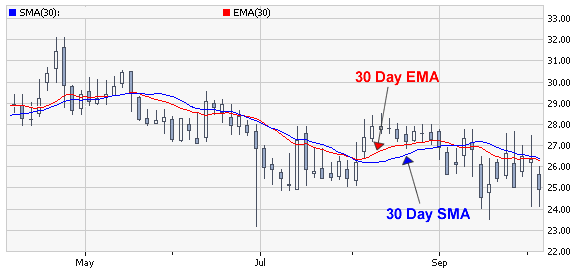Simple Moving Average v Moving Average
Post on: 16 Март, 2015 No Comment

I seldom trade a chart without either a Simple Moving Average (SMA) or an Exponential Moving Average (EMA) displayed. Both are exceptional tools in an e-mini day traders repertoire. Of course, there is no agreement as to exactly which type of moving average works best-and that is as it should be, because no two traders trade with same mind set and personality.
In the world of moving averages there are two contenders for consideration. The diminutive simple moving average (SMA) and the more complicated exponential moving average (EMA). Because the EMA has a more sophisticated method of calculation, many consider it to be the superior of the two averages, but that would be jumping to unfounded conclusions.
The SMA is a basic arithmetic mean: you add together the closing prices from the last 10 periods then divide the product by 10. As I said, the result is a simple arithmetic mean. Pretty simple? Too simple for some people, especially those who tend to associate complexity with efficiency.
Complexity does sometimes yield superior results, but that is not always the case.
EMA’s are really not that much more difficult to calculate. The formula is simply 2 (n+1), and the result is added to the prior days exponential calculation. With some simple deduction you will see that an EMA emphasizes the most recent days prices, or weights the most recent days prices more than prices early in the exponential sequence. Since any moving average uses historical data, or data that has already occurred to calculate the average, any moving average can be considered a lagging indicator. It should be obvious, then, that the purpose of the EMA is to “speed” up the lag factor that is inherent in all moving averages.
Do EMA’s really speed up the lag factor?
To a certain extent EMA make the lag factor in moving averages less distinct, but like all things, there is a cost. EMA’s are notorious for causing a raft of early buy and sell signals, as the last variables in the sequence overweight the average. For that reason alone, I am not a huge fan EMA’s and prefer SMA’s. Does that mean SMA’s are better than EMA’s? Not at all, all it means is that in my trading mentality I am far more comfortable with the results from an SMA than I am an EMA.
I always strike an 89 period SMA on my charts and watch the price action relative to the price action and the SMA. If the price action in more than 3 or 4 points below the SMA(on the ES contract) I immediately decide that long trades are out of the question until the price action moves closer to the SMA, and visa versa on price action about the 89 period SMA. I can also glean some nearly instant information regarding the trend of the market by looking at the slope of the 89 period SMA, and the sharper, or more pronounced the slope appears, the stronger the trend.
I also use a number of paired moving averages to back up some of my entry and exit points. I generally use Fibonacci numbers starting with 5 and up to form my two moving average lines. I find it best, on short term trading, to use to SMA’s that are within 15-20 points of each other. I will leave to you to discover which set of moving averages intersect at point which best suit your trading style.
So we’ve talked a bit about moving averages today, and seen some applications for the SMA. The EMA’s are also used by many traders and I would encourage you to explore the applications for this moving average.














